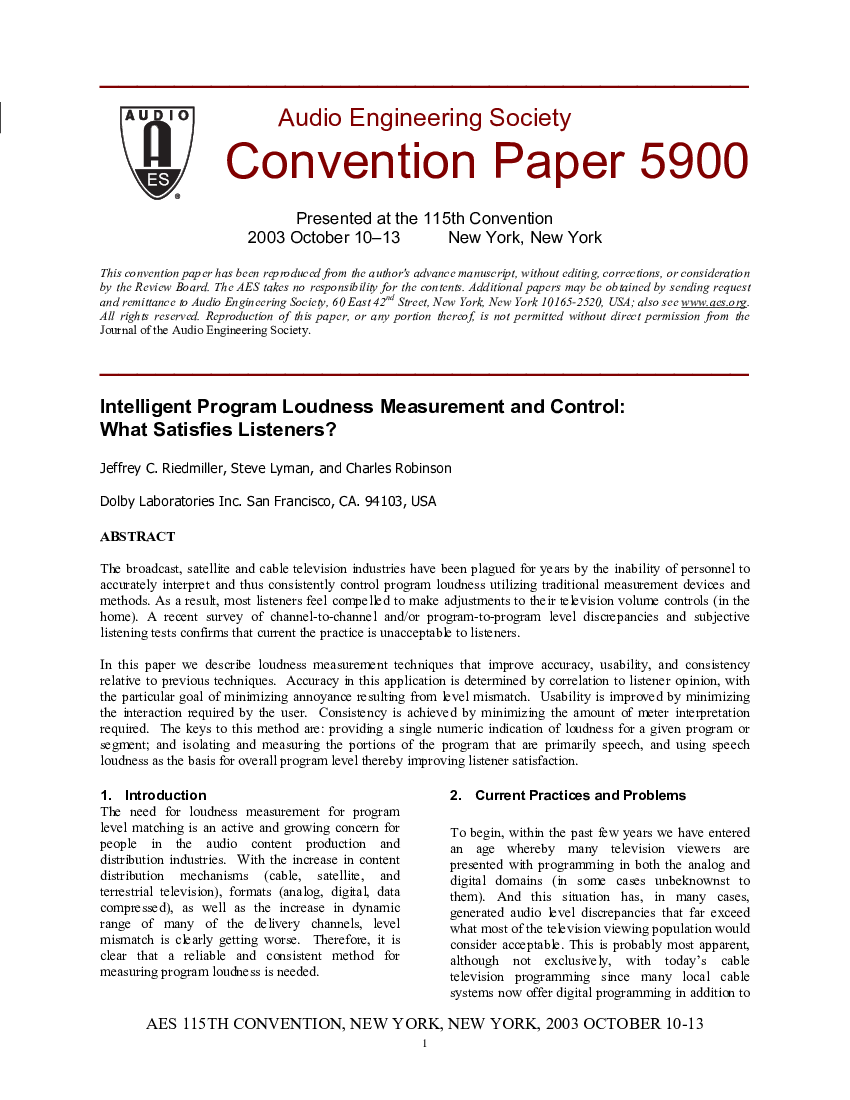Home / Publications / E-library page
You are currently logged in as an
Institutional Subscriber.
If you would like to logout,
please click on the button below.
Home / Publications / E-library page
Only AES members and Institutional Journal Subscribers can download
The broadcast, satellite and cable television industries have been plagued for years by the inability of personnel to accurately interpret and thus consistently control program loudness utilizing traditional measurement devices and methods. As a result, most listeners feel compelled to make adjustments to their television volume controls (in the home). A recent survey of channel-to-channel and/or program-to-program level discrepancies and subjective listening tests confirms that current the practice is unacceptable to listeners. In this paper we describe loudness measurement techniques that improve accuracy, usability, and consistency relative to previous techniques. Accuracy in this application is determined by correlation to listener opinion, with the particular goal of minimizing annoyance resulting from level mismatch. Usability is improved by minimizing the interaction required by the user. Consistency is achieved by minimizing the amount of meter interpretation required. The keys to this method are: providing a single numeric indication of loudness for a given program or segment; and isolating and measuring the portions of the program that are primarily speech, and using speech loudness as the basis for overall program level thereby improving listener satisfaction.
Author (s): Robinson, Charles; Lyman, Steve; Riedmiller, Jeffrey C.
Affiliation:
Dolby Laboratories Inc. San Francisco, CA
(See document for exact affiliation information.)
AES Convention: 115
Paper Number:5900
Publication Date:
2003-10-06
Import into BibTeX
Session subject:
Instrumentation and Measurement
Permalink: https://aes2.org/publications/elibrary-page/?id=12415
(403KB)
Click to purchase paper as a non-member or login as an AES member. If your company or school subscribes to the E-Library then switch to the institutional version. If you are not an AES member Join the AES. If you need to check your member status, login to the Member Portal.

Robinson, Charles; Lyman, Steve; Riedmiller, Jeffrey C.; 2003; Intelligent Program Loudness Measurement and Control: What Satisfies Listeners? [PDF]; Dolby Laboratories Inc. San Francisco, CA; Paper 5900; Available from: https://aes2.org/publications/elibrary-page/?id=12415
Robinson, Charles; Lyman, Steve; Riedmiller, Jeffrey C.; Intelligent Program Loudness Measurement and Control: What Satisfies Listeners? [PDF]; Dolby Laboratories Inc. San Francisco, CA; Paper 5900; 2003 Available: https://aes2.org/publications/elibrary-page/?id=12415
@article{robinson2003intelligent,
author={robinson charles and lyman steve and riedmiller jeffrey c.},
journal={journal of the audio engineering society},
title={intelligent program loudness measurement and control: what satisfies listeners?},
year={2003},
number={5900},
month={october},}